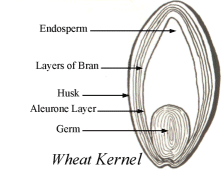![]()

There is a wide variety of grains: rice, millet, oats and others less familiar. They have been, and still are, staple food for some civilizations and cultures.
The ancient Chinese depended upon millet, buckwheat, and rice as their staples; the Aztecs and Mayans subsisted mainly on corn; the Egyptians grew some of the world's finest wheat.
Our way of eating have changed with time, leaving the cereals on the side. Even if some countries have kept their ancestral recipes, it is now seldom to find recipes with barley, quinoa or other cereals in our cookbooks.
Composition
They are composed of complex carbohydrates (between 60 and 80 % of the calories in grains come from carbohydrate). They provide proteins, B vitamins (thiamine, riboflavin, and niacin), vitamin E for some of them and minerals (iron, zinc, calcium, selenium and magnesium).
If they are non processed, they also are an excellent source of fiber.
However the protein is incomplete. Cereals are deficient in lysine, an essential amino acid. But it is possible to complete this deficiency by eating foods that contain this amino acid such as legumes.
Description
Cereal groups contain true grains such as wheat, rice, oats, rye, millet, corn which are members of the grass family Graminea and non-true grains such as amaranth, quinoa, and buckwheat which belong to different botanical families.
Because the kernels of all of these have a similar composition they all belong to the cereal family.
The grain itself is composed of different parts:
![]()

The more a grain is processed, the more it has lost its nutrients
|
Calories
|
Proteins
|
Fats
|
Carbohydrates
|
Fibre
|
Calcium
|
Zinc
|
Phosphorus
|
Iron
|
Sodium
|
Potassium
|
Thiamine
|
Riboflavin
|
Niacin
|
|
|
Wheat berry
|
332 g
|
10.5 g
|
1.5 g
|
69 g
|
1.9 g
|
40 mg
|
5.50 mg
|
300 mg
|
4 mg
|
12 mg
|
450 mg
|
0.40 mg |
0.2 mg
|
4 à 8 mg
|
|
Whole wheat flour
|
340 g
|
10.5 g
|
1.5 g
|
71 g
|
2 g
|
40 mg
|
5.50 mg
|
300 mg
|
4 mg
|
10 mg
|
450 mg
|
0.35 mg |
0.2 mg
|
4 à 8 mg
|
|
White flour
|
353 g
|
9.5 g
|
1.2 g
|
75 g
|
0 g
|
16 mg
|
1.7 mg
|
120 mg
|
1.2 mg |
3 mg
|
135 mg
|
0.1 mg |
0.08 mg
|
0.6 mg
|
|
Wheat germ
|
390 g
|
25.2 g
|
10 g
|
49.5 g
|
1 g
|
90 mg
|
2 mg
|
1100 mg
|
8 mg
|
0 mg
|
780 mg
|
1 à 1.50 mg |
1 à 4 mg
|
5 mg
|
Realized by Laurence LIVERNAIS-SAETTEL, dietitian
© Copyright L. Livernais-Saettel 2002
Site hosted by MaVille-Online.